Friday, 6 March 2015: More meetings and the Fort
Written 7 March 2015
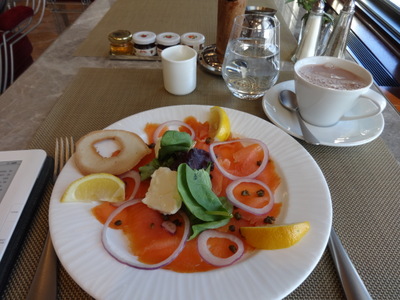
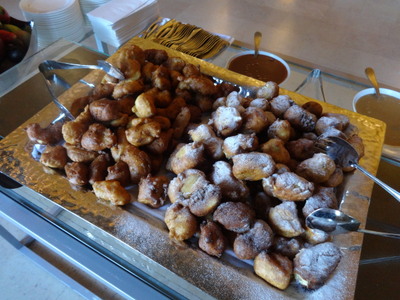 On Friday, it was cold—minus 11°F overnight and 10°F during the afternoon. Once again, David decided to skip breakfast in favor of extra sleep and went straight to the meetings. He would sleep in longer, but they keep assigning him to judge the first papers of the mornings.
On Friday, it was cold—minus 11°F overnight and 10°F during the afternoon. Once again, David decided to skip breakfast in favor of extra sleep and went straight to the meetings. He would sleep in longer, but they keep assigning him to judge the first papers of the mornings.
I had the smoked salmon plate for breakfast—lots of sliced smoked salmon, red onions, capers, blocks of cream cheese, a few leaves of salad, lemon wedges, a little pitcher of olive oil on the side, plus one very thin crisp slice of bagel. Very good indeed, but I would have preferred to have more (and less crisp) bagel.
At the right is the organizer's brilliant choice of munchie for the morning break—wedges of apple and chunks of banana dipped in batter and fried into little crisp doughnuts, served warm with raspberry and maple sauces. I admit it; I succumbed and ate one of each flavor—outstanding!
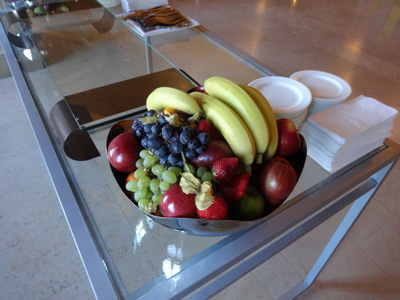
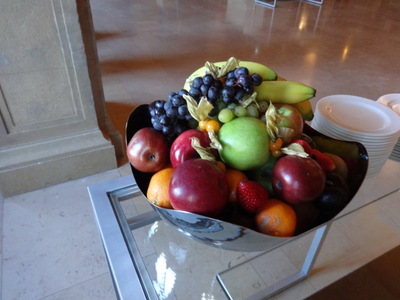 Here are two of the four fruit bowls set out to accompany the fruit fritters, shown before the hordes descended on them. Each assortment on each day is a little different, but these are typical—three colors of apples, two or three colors of grapes, oranges, tangerines, Bosc and red Bartlet pears, bananas, strawberries, kiwis, Physalis berries.
Here are two of the four fruit bowls set out to accompany the fruit fritters, shown before the hordes descended on them. Each assortment on each day is a little different, but these are typical—three colors of apples, two or three colors of grapes, oranges, tangerines, Bosc and red Bartlet pears, bananas, strawberries, kiwis, Physalis berries.
In the course of each 15- to 20-minute break, the participants (about 400 people, total) chew through them like locusts! After the break, each bowl typically contains maybe a couple of pears and a tangerine. Bosc pears seem the least popular—I think maybe people don't know what they are.
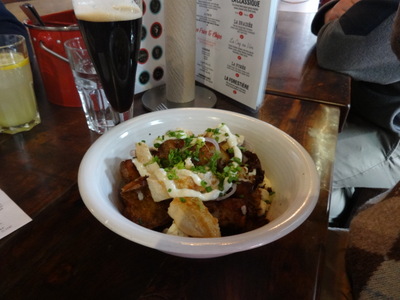
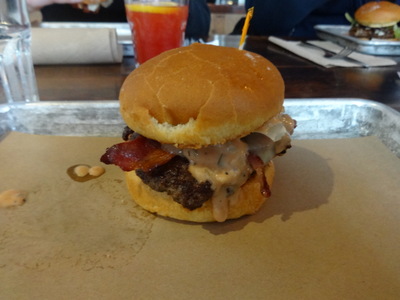 Because the benthic meetings tend to be so intense, the organizers decided to leave Friday afternoon free for tourism, so that nobody's brain got too fried.
Because the benthic meetings tend to be so intense, the organizers decided to leave Friday afternoon free for tourism, so that nobody's brain got too fried.
We planned to visit the nearby Musée du Fort, just a block away, so we and a couple of colleagues went to seek lunch at the Chic Shack, next door to the museum. Surprisingly, very little chicken appeared on the menu. At the left is David's "coq au vin poutine," which did contain chicken (though hardly coq au vin) and turned out to be outstanding. The potatoes were not the usual fries but more like the crispy potato skins served in fern bars.
At the right is my burger, the actual specialty of the place. I started with the basic beef cheeseburger, but they come in venison, bison, chicken, vegetarian, and lobster (they were out of that one) with different cheese, sauces, and toppings (e.g., homemade pickles). It was good, but unfortunately, they insist on overcooking them, so I wouldn't order the same thing again. They were having technical difficulty with some of their machinery, so they had no milkshakes that day, and the much vaunted house-made fruit sodas were being made with flat tap water rather than carbonated. My side of sweet potato fries was excellent.
David threw caution to the winds and ordered a beer, Archibald Veuve Noir (a locally brewed Irish-style dry stout).
Written 9 March 2015
The museum was very small and was centered around a three-dimensional model of the Quebec area on which (and on a video screen above which) a very effective mixed-media light and sound show outlined the history of the area, with emphasis on the British invasion that led to the British conquest. It was the culmination of a long cherished concept by a local history teacher turned attorney, who started the project back in the 1950s. David sat through the show but decided to skip the rest of the museum and head back to the hotel. He knew IPAs disagreed with him; now he can add the veuve noir (which means "black widow") to the list he shouldn't drink.
The "rest of the museum" turned out to be very small, just the materials hung on the walls of the stairwells from the ground floor to the floor with the show and from that floor to the top floor. They included things like prints of the two famous paintings, one of the death of Montcalm (the general commanding the French forces) and the other of the death of Wolfe (the general commanding the British forces), both of whom were killed in the battle that culminated in the conquest. The best item on display was a long horizontal poster of the time line of Canadian history. I was sorely tempted, but they wanted $23 for it; I just took photos of the one on display instead.
The gift shop also sold books on the history of Canada, one shelf in French and the other in English. Among those on the French shelf was Maria Chapdelaine, a novel of the Canadian north country, which a friend had already recommended to me on hearing I would be in Québec. I've since downloaded it from Gutenberg.org to read when I get the chance. It's set in the Lac Saint-Jean area, the very place the delicious meat pie at Aux Anciens Canadiens supposedly comes from!
Back at the hotel, when I appeared in the lobby at the appointed time to meet David for the walk to the Morrin center, where the evening's social and "Beneath the Waves" film festival were to take place, David came downstairs only to say that he'd decided not to go. On the one-block walk back from lunch, with his stomach already upset, he "froze his sinuses" and didn't want to go out again.
The Morrin Center turned out to be very different from what I expected—I was picturing something more like either a municipal museum or a municipal auditorium. In fact, it is an old building, stone on the outside but largely wooden inside, that is now the cultural center of Anglophone Québec.
We entered to find ourselves in a rather cramped lobby flanked by a pair of wooden stairways leading up. Volunteers from among the benthic-meeting organizers were conducting a surprisingly efficient cloak-room operation in the space between the staircases, taking our coats, hats, scarves, and shoes and stashing them someplace out of sight. (Street shoes weren't allowed any farther inside, at least in snow/slush/salt season, because the building still has its original wooden floors.) After that, you had the choice of walking around in your stocking feet or of borrowing a pair of slippers from a large heap made available for the purpose, so I spent the evening in furry pink scuffs. Many people chose not to give their shoes or boots to the cloak-room, so the corners of the already small room were drifted three feet deep in heaps of footwear. The young people were standing elbow to elbow in the cramped space, struggling their way out of their parkas and passing them over each other's heads to the cloak-room; for us old folks, a few chairs were available for putting on and taking off shoes.
Once I was appropriately shod and had my cloak-room check in my hand, I went up the stairs, where I was handed a little map of the building, asked for my chit showing that we had paid for the social, and then presented with a commemorative glass beer mug bearing the logo of the meetings. I didn't think I was entitled to the mug, because I didn't have the appropriate chit, and I couldn't imagine David's opting to receive one, but they insisted on giving me one anyway. Of course, they were giving everyone in the building a mug identical to all the others and recommending that we use them all evening, then take them home. Clearly, someone had given thought to this potentially confusing situation, though—each mug came with a little paper ID label (preprinted in most cases; hand written in mine) and a tiny cable tie with which to attach it to the mug's handle. You would therefore set your mug down anywhere and come back for it later, without its being mistaken for anyone else's—very useful as I went off to tour other parts of the building and encountered "no drinks in the stairwells" signs.
From the mug-dispensing station, I continued into the large room where the social was in progress and where the film festival would later take place. After studying the little map, I set off to see what there was to see.
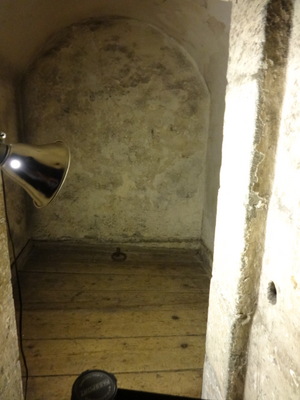
 The building was built, under the French, to be the city's first prison, and a section of the old stone cells has been preserved. One of them is shown here, and as you can see they are about twice the size of those preserved in the Beaux Arts—on the other hand, they were intended for double occupancy. The cells were arranged around a central stone room with an iron stove and a table seating 8 to 10. Apparently, the prisoners were let out of their cells to eat together at the table. In good weather, they were sent out to hard labor. When that wasn't feasible, they worked at other tasks around the table.
The building was built, under the French, to be the city's first prison, and a section of the old stone cells has been preserved. One of them is shown here, and as you can see they are about twice the size of those preserved in the Beaux Arts—on the other hand, they were intended for double occupancy. The cells were arranged around a central stone room with an iron stove and a table seating 8 to 10. Apparently, the prisoners were let out of their cells to eat together at the table. In good weather, they were sent out to hard labor. When that wasn't feasible, they worked at other tasks around the table.
A docent dressed as an 18th-century prison guard explained these procedures, pointed out the cell used for solitary confinement, and indicated the locations of especially interesting graffiti.
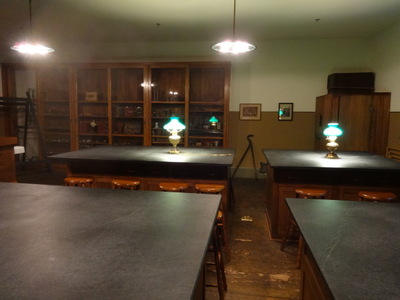
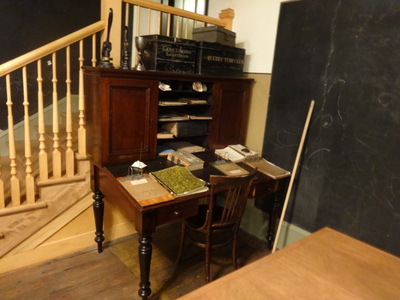 After the conquest, in 1848, a Mr. Morrin decided that the city's Anglophone minority—about 40% of the population at the time—needed its own institution of higher learning, Anglophone of course, so he founded one, in this building. The chemistry lab (actually the all-sciences lab, but at the time, science meant chemistry) has been preserved to illustrate that period. Another docent, this one in a hoop skirt, was on hand to answer questions.
After the conquest, in 1848, a Mr. Morrin decided that the city's Anglophone minority—about 40% of the population at the time—needed its own institution of higher learning, Anglophone of course, so he founded one, in this building. The chemistry lab (actually the all-sciences lab, but at the time, science meant chemistry) has been preserved to illustrate that period. Another docent, this one in a hoop skirt, was on hand to answer questions.
Everyone who entered the room—all scientists, remember—immediately ran an admiring, not to say envious, hand over the beautiful slate lab benches (which, alas, are not the originals).
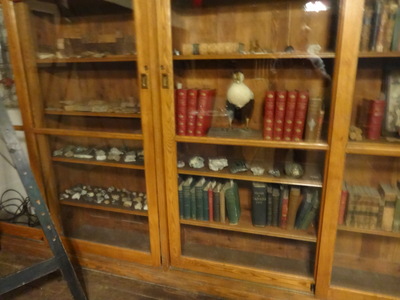
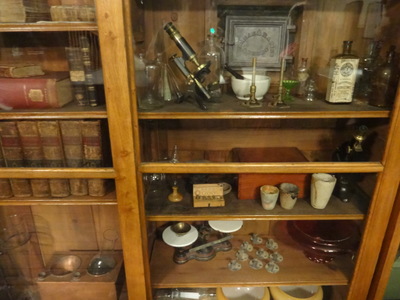 The teaching collection apparently originally included a large collection of stuffed specimens, but the lonely eider duck in the rather blurry photo at the left is the only one that has survived.
The teaching collection apparently originally included a large collection of stuffed specimens, but the lonely eider duck in the rather blurry photo at the left is the only one that has survived.
The college closed its doors in 1902, when the Anglophone population was no longer large enough to sustain it, and the collections underwent a long period of neglect while the building stood empty.

 The final stop on the tour was the library. Originally it was the library of Morrin College, and many of the original volumes have been preserved, in the less-trafficked upper gallery, but today, it is extremely active as the city's only Anglophone lending library. This photo takes in about a quarter of the collection. A $20 membership fee entitles the member to use it as though it were a public library, checking out up to a half a dozen books at a time. The docent there, dressed as a 19th-century librarian, of course, is a member of today's Anglophone minority (defined as those that, for preference, speak English in the home), now down to about 1% of the population. The city has two Anglophone public schools, and to attend one of them, you must (a) prove you speak English at home and (b) have at least one parent who attended one of them. Without these restrictions, the majority Francophone population would simply use them as English-immersion schools and crowd out the "real" English speakers. As it is, students in the French schools take English courses, and those in the English schools take French courses. The docent in the chemistry lab, a Francophone, remarked that the Anglophone community was really very small—"working here, you pretty much know all of them."
The final stop on the tour was the library. Originally it was the library of Morrin College, and many of the original volumes have been preserved, in the less-trafficked upper gallery, but today, it is extremely active as the city's only Anglophone lending library. This photo takes in about a quarter of the collection. A $20 membership fee entitles the member to use it as though it were a public library, checking out up to a half a dozen books at a time. The docent there, dressed as a 19th-century librarian, of course, is a member of today's Anglophone minority (defined as those that, for preference, speak English in the home), now down to about 1% of the population. The city has two Anglophone public schools, and to attend one of them, you must (a) prove you speak English at home and (b) have at least one parent who attended one of them. Without these restrictions, the majority Francophone population would simply use them as English-immersion schools and crowd out the "real" English speakers. As it is, students in the French schools take English courses, and those in the English schools take French courses. The docent in the chemistry lab, a Francophone, remarked that the Anglophone community was really very small—"working here, you pretty much know all of them."
The library docent was proudly showing off a murder mystery by Canadian author Louise Penny in which the body is discovered in this very library. Coincidentally, David and I are currently reading our first Louise Penny mystery, A Rule Against Murder—next, we'll have to read the one set at the Morrin, Bury Your Dead.
To the right of the photo of the library is a shot of some of the munchies served at the social, which consisted of (a) veggie platters with dip, (b) cheese platters with grapes but no crackers, and (c) a blend that came ready-mixed in big bags of two flavors of Doritos, Sunchips, pretzels, and crunchy Cheetos.
The "Beneath the Waves" film festival, an annual feature of the benchic meetings, is an hour-long collection of short films about just about anything in the ocean. It was divided into three showings, at 7:30, 8:30, and 9:30 p.m., because seating was so limited, so although it was free, but you had to have a ticket. Mine was for the first showing. At the appointed hour, the meeting organizer stood on a balcony overlooking social and shouted that everyone must leave the room by the far door, go through the library, and continue down the stairs into the cramped little lobby. Those with 7:30 p.m. tickets could then cross the lobby and come back up the room by the original staircase, presenting their tickets for readmission. He recommended that all others leave the building—go find dinner in some nearby eatery, he suggested, and come back later. Meanwhile, the volunteer corps was setting up rows of folding chairs where we had been standing around munching before.
Scoresheets were distributed, on which we could rank the top three films and in addition indicate which was the best student-produced film. The films themselves ranged from a claymation depiction of the life cycle and conservation of the spiny lobster (charming!), a documentary on the destructive effects of ghost-fishing lobster traps, effects of land run-off on the nearshore environment of Easter Island, potential for medical application of quorum sensing among bacterial symbionts of a small squid, and trials and tribulations of a grad student studying sea grasses, to an ingenious device to repressurize (and thus avoid killing of) undersized fishes accidentally brought to the surface by hook-and-line fishers. All very good.
David apparently had something to eat at the hotel, and I skipped dinner. I had some cheese and cheetos at the social, and I'd been eating way to much for the last few days anyway.
previous entry
List of Entries
next entry

 On Friday, it was cold—minus 11°F overnight and 10°F during the afternoon. Once again, David decided to skip breakfast in favor of extra sleep and went straight to the meetings. He would sleep in longer, but they keep assigning him to judge the first papers of the mornings.
On Friday, it was cold—minus 11°F overnight and 10°F during the afternoon. Once again, David decided to skip breakfast in favor of extra sleep and went straight to the meetings. He would sleep in longer, but they keep assigning him to judge the first papers of the mornings.
 Here are two of the four fruit bowls set out to accompany the fruit fritters, shown before the hordes descended on them. Each assortment on each day is a little different, but these are typical—three colors of apples, two or three colors of grapes, oranges, tangerines, Bosc and red Bartlet pears, bananas, strawberries, kiwis, Physalis berries.
Here are two of the four fruit bowls set out to accompany the fruit fritters, shown before the hordes descended on them. Each assortment on each day is a little different, but these are typical—three colors of apples, two or three colors of grapes, oranges, tangerines, Bosc and red Bartlet pears, bananas, strawberries, kiwis, Physalis berries.
 Because the benthic meetings tend to be so intense, the organizers decided to leave Friday afternoon free for tourism, so that nobody's brain got too fried.
Because the benthic meetings tend to be so intense, the organizers decided to leave Friday afternoon free for tourism, so that nobody's brain got too fried.
 The building was built, under the French, to be the city's first prison, and a section of the old stone cells has been preserved. One of them is shown here, and as you can see they are about twice the size of those preserved in the Beaux Arts—on the other hand, they were intended for double occupancy. The cells were arranged around a central stone room with an iron stove and a table seating 8 to 10. Apparently, the prisoners were let out of their cells to eat together at the table. In good weather, they were sent out to hard labor. When that wasn't feasible, they worked at other tasks around the table.
The building was built, under the French, to be the city's first prison, and a section of the old stone cells has been preserved. One of them is shown here, and as you can see they are about twice the size of those preserved in the Beaux Arts—on the other hand, they were intended for double occupancy. The cells were arranged around a central stone room with an iron stove and a table seating 8 to 10. Apparently, the prisoners were let out of their cells to eat together at the table. In good weather, they were sent out to hard labor. When that wasn't feasible, they worked at other tasks around the table.
 After the conquest, in 1848, a Mr. Morrin decided that the city's Anglophone minority—about 40% of the population at the time—needed its own institution of higher learning, Anglophone of course, so he founded one, in this building. The chemistry lab (actually the all-sciences lab, but at the time, science meant chemistry) has been preserved to illustrate that period. Another docent, this one in a hoop skirt, was on hand to answer questions.
After the conquest, in 1848, a Mr. Morrin decided that the city's Anglophone minority—about 40% of the population at the time—needed its own institution of higher learning, Anglophone of course, so he founded one, in this building. The chemistry lab (actually the all-sciences lab, but at the time, science meant chemistry) has been preserved to illustrate that period. Another docent, this one in a hoop skirt, was on hand to answer questions.
 The teaching collection apparently originally included a large collection of stuffed specimens, but the lonely eider duck in the rather blurry photo at the left is the only one that has survived.
The teaching collection apparently originally included a large collection of stuffed specimens, but the lonely eider duck in the rather blurry photo at the left is the only one that has survived.
 The final stop on the tour was the library. Originally it was the library of Morrin College, and many of the original volumes have been preserved, in the less-trafficked upper gallery, but today, it is extremely active as the city's only Anglophone lending library. This photo takes in about a quarter of the collection. A $20 membership fee entitles the member to use it as though it were a public library, checking out up to a half a dozen books at a time. The docent there, dressed as a 19th-century librarian, of course, is a member of today's Anglophone minority (defined as those that, for preference, speak English in the home), now down to about 1% of the population. The city has two Anglophone public schools, and to attend one of them, you must (a) prove you speak English at home and (b) have at least one parent who attended one of them. Without these restrictions, the majority Francophone population would simply use them as English-immersion schools and crowd out the "real" English speakers. As it is, students in the French schools take English courses, and those in the English schools take French courses. The docent in the chemistry lab, a Francophone, remarked that the Anglophone community was really very small—"working here, you pretty much know all of them."
The final stop on the tour was the library. Originally it was the library of Morrin College, and many of the original volumes have been preserved, in the less-trafficked upper gallery, but today, it is extremely active as the city's only Anglophone lending library. This photo takes in about a quarter of the collection. A $20 membership fee entitles the member to use it as though it were a public library, checking out up to a half a dozen books at a time. The docent there, dressed as a 19th-century librarian, of course, is a member of today's Anglophone minority (defined as those that, for preference, speak English in the home), now down to about 1% of the population. The city has two Anglophone public schools, and to attend one of them, you must (a) prove you speak English at home and (b) have at least one parent who attended one of them. Without these restrictions, the majority Francophone population would simply use them as English-immersion schools and crowd out the "real" English speakers. As it is, students in the French schools take English courses, and those in the English schools take French courses. The docent in the chemistry lab, a Francophone, remarked that the Anglophone community was really very small—"working here, you pretty much know all of them."